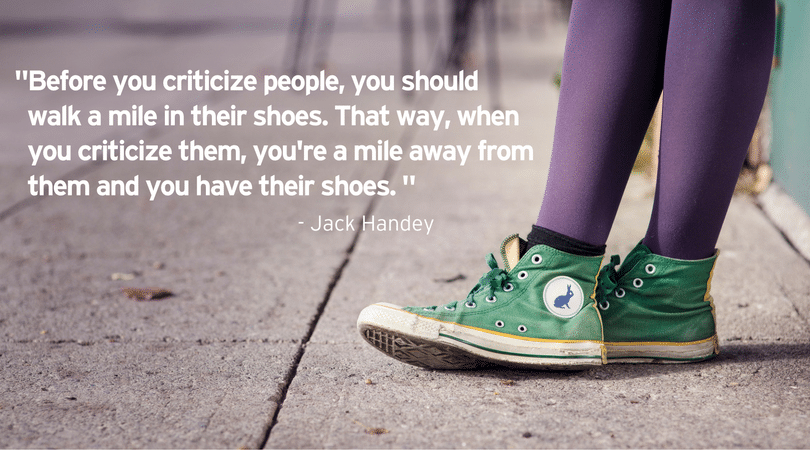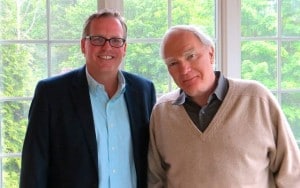Every story starts with empathy
I love Jack Handey. His Deep Thoughts from Saturday Night Live always cracked me up.
I came across the one above last week while reading Originals, How Non-Conformists Move the World by Adam Grant. Although Grant was talking about criticism in the workplace, the “…walk a mile in their shoes” made me think of having empathy for your audience.
Plus, I had a good laugh at the same time.
You must research, understand and appreciate what your audience is going through so that you can craft and tell a story that resonates on their terms.
The best way to identify their journey is to use the same Story Cycle process that defined your brand story. It works because the 10 steps reflect a universal structure to story that we all experience. Understand the pattern and you will develop insight into how your customer stories – and their lives – unfold.
10 Q’s to create accurate customer personas
This particular exercise is found in chapter 2 of the Story Cycle titled Who’s Your Hero? Use these 10 questions to better understand your number one audience and see what you learn about them.
Q1: Backstory: Where has your customer been, where are they now, and where do they want to go?
Q2: Hero: What are the demographics, psychographics and motigraphics (their motivation) of your customer?
Q3: Stakes: What is important to them both personally and professionally relative to your offering and where does your audience land on the Adoptive Curve Scale: Innovator, Early Adopter, Early Majority, Late Majority or Laggard?
Q4: Disruption: What has or is going to change in their environment to turn their ordinary world upside down and make your offering more relevant than ever?
Q5: Antagonists: Who and what stands in their way – including their own internal dragons – of adopting, using and evangelizing your offering?
Q6: Mentor: How does your brand’s position, promise, personality and purpose help your customer achieve what they want?
Q7: Journey: How will their journey unfold using your product or service?
Q8: Victory: What does initial success look like through the eyes of your customer?
Q9: Moral: What does success feel like: how does it connect the beliefs and values you share with your customer?
Q10: Ritual: How will your customer interact with your offering now and in the future to create a lasting brand bond, ritual and evangelism?
The Business of Story Audience Persona
Here is an example of how I used a singular person to reflect the general personality of my core audience. Sam, or Samantha if you prefer, runs a healthcare technology firm, which is a proxy for any kind of mid-market company that has a proven business model, but their growth is being slowed by the lack of a clear and compelling brand story that everyone can buy into and prosper from.
Backstory: Sam is the founder and CEO of a seven-year-old healthcare technology firm that he started in a co-working space, which has grown to 30 employees now headquartered in his own 10,000 square foot building. Business has been brisk, but as they emerge as a mid-market tech company, Sam knows that the organization, while focusing on expert delivery of their product and customer service, have neglected defining their brand story and aligning it with their employees and customers. Therefore, he has urgency to create a brand narrative to spur the next level of growth for his organization.
Hero: Sam is 37 years old, married and the father of two kids active in sports, with some reluctant piano lessons scheduled in, because the arts are important, too. In fact, he believes coding is a blend of art and science to unlock the potential of users. He is a driven entrepreneur who analyzes every business move, and requires a lot of data and proof in his decision making. He runs four times a week, meditates occasionally, and eats healthy, because he knows it’s good for him and he feels it’s important to model healthy behavior throughout his organization and industry.
Stakes: While focused on outstanding product delivery and fastidious customer service that have led to growing sales, he feels the company is falling short because they have not clarified their brand story. Although an Innovator in some areas of his operations and personal buying habits, Sam is more of a late Early Adopter/Early Majority when investing in professional services for his company. For instance, he has just implemented leadership coaching after considering it for two years.
Disruption: Sam knows international growth means being more professional through all of their advertising, marketing and sales, but everyone in his organization seems to be telling their own story about the brand and its offering. If they are going to continue to double growth every year, he knows that he must unify the organization around one central brand story that they can all buy into and prosper from. And it must be accurately and powerfully reflected through all of their advertising and inbound marketing and sales.
Antagonists: As an analyzer, Sam has difficulty getting out of his own way to make a decision. He needs proof and recommendations from others before he will invest. He is also concerned about the resources required to get his brand story straight, but is starting to appreciate the importance of making the investment of time and money.
Mentor: Results of the epic growth clients have achieved through the Story Cycle process will be critical for Sam’s decision to proceed. The systematic approach of the 10-step process with deliverables in each chapter demonstrating tangible progress is important to his analytical mind. Plus, the combination of Hollywood storytelling coupled with brand marketing plays to his art sensibilities.
Journey: Sam’s awareness of the Business of Story platform comes from a referral. He will adopt the program by first doing a one-on-one session to vet the Story Cycle process, which may mean attending a one-day workshop. He may also use some of the free online storytelling tools to test the quality of the materials. He will then invite his leadership team into the process to develop the overall brand story, because building consensus in his organization is profoundly important to Sam. Appreciation will come following the workshop, and be evangelized once his overall brand story is created.
Victory: Sam will be inspired by the workshop and will look forward to getting his team involved in a process that he found and vetted for the company. We will celebrate the creation of their brand story by rolling it out to the organization with great fanfare. Our goal is to make Sam a vocal ambassador of the Business of Story platform and the Story Cycle process, which he will happily share with his peers and colleagues.
Moral: Sam values a proven, intentional process that is an enchanting combination of art, science and sales – a process that aligns his leadership, brand, employee and customer stories to deliver real results for his organization and people in a timely fashion.
Ritual: We will arm Sam with the story plans and tools to embed storytelling throughout his organization for the growth of his people and enterprise, while also providing the online portal of businessofstory.com for rich content around storytelling.
You can download a PDF of the above audience persona creation process.
I must close with another Jack Handey favorite…
“I hope life isn’t a big joke, because I don’t get it.”
Are you ready to get your brand story straight?
Get your storytelling marketing started with the DIY guide to compelling brand stories that sell. Learn More.
Business Story Strategist, Keynote Speaker and Brand Raconteur
Park Howell is a trusted brand story strategist and sought-after keynote speaker on story marketing. He has helped international brands, including Coca-Cola, Beyer Pharmaceutical, Cummins Diesel, American Express, and United States Air Force.
The widely popular Business of Story podcast helps leaders of purpose-driven organizations clarify their stories to grow revenue and amplify their impact. Each episode brings you the brightest content creators, advertising creatives, authors, screenwriters, makers, marketers, and brand raconteurs that show you how to craft and tell compelling brand stories that sell.
Learn more about working with Park Howell and getting your brand story straight on our website.













